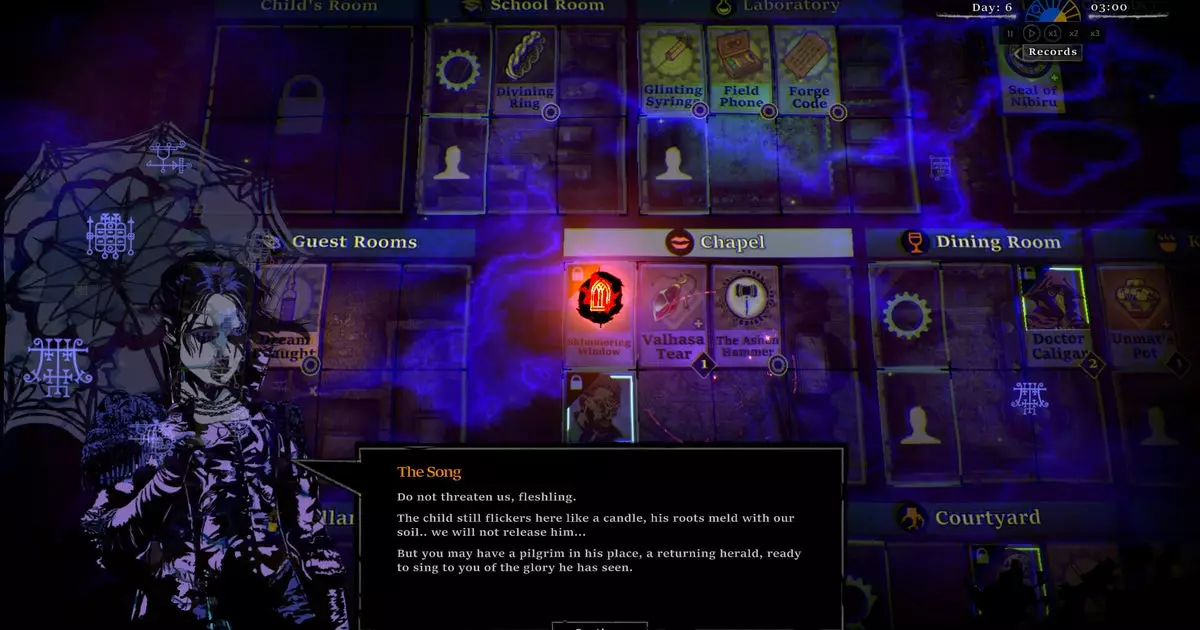The gaming landscape is ripe with opportunities for innovation, particularly within atmospheric role-playing games (RPGs) that blend mystery, exploration, and strategic management. One title that piqued my interest recently is The Horror At Highrook, a game that artfully intertwines a picturesque yet eerie world with the necessity for strategic decision-making. As players journey through the haunted corridors of Highrook Manor, they are not only enveloped by an immersive ambiance but also challenged by a complex interplay of resource management, character development, and narrative unraveling.
From the outset, The Horror At Highrook captivates players with its enchanting visuals. The game transitions seamlessly from the bleakness of daytime to the vibrant reds of sunset, ending in the subtle hues of a lavender moonlit night. These color shifts evoke a sense of time passing and the changing moods of the environment, effectively drawing players deeper into the narrative. There’s a cinematic quality to the visuals, with minute details that beckon the eye — from the rhythmic patter of rain to flickering flames that illuminate the dark recesses of the mansion. It’s difficult not to be reminded of other beloved titles that prioritize artful storytelling through visuals, where atmosphere serves as a character in its own right.
Yet, amid this sensory indulgence, players must remain vigilant; the idle hands of time are unforgiving. Characters are not mere avatars but entities that require attention; neglecting their needs can lead to detrimental consequences like hunger and fatigue. This mechanic aligns with the game’s overarching theme of survival mixed with exploration, echoing the challenges often faced in rogue-like titles where choices matter and consequences loom heavily on every decision.
At the heart of The Horror At Highrook lies a robust system of task management. Players will find themselves orchestrating their teams in a manner reminiscent of beloved titles from the past, albeit with a fresh twist. Assigning characters to various locations within the mansion is essential — whether it’s preparing meals in the kitchen, gleaning crucial information from dusty archives, or toiling in the garden to unearth hidden treasures. The myriad of tasks, driven by resource needs, pushes players toward engaging strategy, as skills and attributes must be optimally matched with the challenges they face.
The use of cards further enriches the gameplay experience by introducing unique abilities and enhancements. Each character may be equipped with items or “visions” that enhance their capabilities. For example, one card might bestow a mysterious trait that aids in laboratory work, while another assists mechanical tasks in a workshop. This card system fosters an engaging layer of strategy, as players must frequently recalibrate their plans based on the dynamic state of their team, their available resources, and the evolving narrative.
The narrative woven within The Horror At Highrook is anything but simple. The plot thickens around the enigmatic disappearance of the Ackeron family, with players piecing together clues scattered throughout the mansion. This constant exploration of hidden secrets mirrors the investigative essence found in classic mystery games like Cluedo, albeit with an unsettling twist reminiscent of gothic writers like Poe or Lovecraft. The layers of narrative complexity juxtaposed with the horror elements ensure that players remain engrossed as they untangle the haunting secrets of Highrook Manor.
As with any art form, there are rough edges present in The Horror At Highrook that warrant discussion. Some elements feel less polished, such as character accents that could benefit from greater definition. Understanding the nuances that shape characters can enhance immersion, but viewers may find themselves momentarily distracted by inconsistency. Nevertheless, these imperfections offer an opportunity for growth — an invitation for players to explore and find their footing within this richly crafted world.
The Horror At Highrook offers an intriguing blend of atmospheric design, resource management, and captivating storytelling that sets it apart in the indie RPG landscape. It invites players to delve into its shadowy depths while balancing the demands of survival and the thrill of uncovering mysteries. While the game is still in its early stages and may show signs of need for refinement, it’s clear that the potential for a deeply engaging experience lingers just beneath the surface—a haunting journey worth embarking on. Whether you’re a seasoned RPG player or a newcomer drawn by the promise of intricate world-building, The Horror At Highrook is an adventure that should not be missed.


Leave a Reply